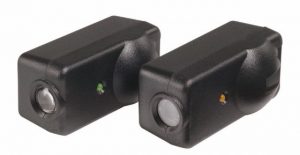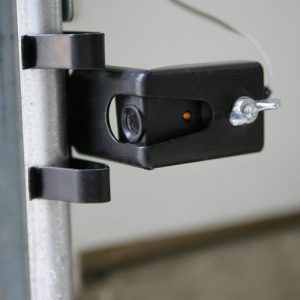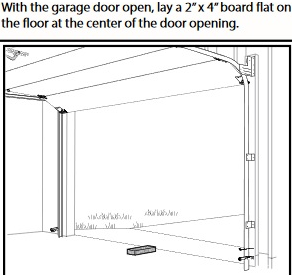
Garage doors are common items in many homes, which results in most people not even giving them much thought. This can lead to problems, as garage doors are relatively heavy items with moving parts. An improperly installed or poorly maintained garage door can cause damage to itself, or harm to a person or a pet. This guide will demonstrate the two main safety devices required on garage doors, and how to verify that they are working properly.

All motorized garage doors should be supplied with electronic sensors. These sensors are mounted no more than 6” from the floor at each side of the garage door. An invisible beam of light is emitted from one sensor and received by the other sensor. Whenever something or someone blocks the beam of light while the door is closing, such as a child walking across the opening, the opener senses this interruption in the beam of light, automatically stops the door from closing and open the door back up. These sensors must be aligned properly to function. Most sensors have one green light and one amber light, which are visible on the sides of the sensors when they are properly aligned.

If the sensors are not aligned, this usually results in the door not closing when the control button is pushed. In this case, the sensor can be temporarily bypassed to close the door by holding the control button down until the door closes. When testing the garage door while closing, passing your leg through the (invisible) beam between the two sensors should activate the safety feature, and the door should reverse.
 All motorized garage doors should be supplied with a pressure sensing auto-reverse feature. This sensor, which is built in to the unit, detects when the garage door hits an obstruction (an object, person or pet) on the way down. It is intended to automatically stop the door from closing and open the door back up. Very old model openers did not have this safety feature, and should be upgraded. Many units had manual adjustment buttons available for the homeowner to properly adjust the force required for the auto-reverse feature to engage, and should be properly adjusted to ensure safe operation.
All motorized garage doors should be supplied with a pressure sensing auto-reverse feature. This sensor, which is built in to the unit, detects when the garage door hits an obstruction (an object, person or pet) on the way down. It is intended to automatically stop the door from closing and open the door back up. Very old model openers did not have this safety feature, and should be upgraded. Many units had manual adjustment buttons available for the homeowner to properly adjust the force required for the auto-reverse feature to engage, and should be properly adjusted to ensure safe operation.
Many new units lack homeowner adjustment buttons, and a garage door professional should be consulted if there are any problems with this feature.  Most garage door manufacturers recommend testing this feature by placing a 2” x 4” piece of wood flat on the ground at the center of the door, and closing the door using the controls. The door should stop at the wood and then reverse. If the door stops on the block of wood, it is likely that the auto-reverse feature needs adjustment, and a garage door contractor should be consulted for further testing and adjustment.
Most garage door manufacturers recommend testing this feature by placing a 2” x 4” piece of wood flat on the ground at the center of the door, and closing the door using the controls. The door should stop at the wood and then reverse. If the door stops on the block of wood, it is likely that the auto-reverse feature needs adjustment, and a garage door contractor should be consulted for further testing and adjustment.
Garage door manufacturers recommend that these safety features be tested on a monthly basis to verify their proper function. If there are any problems with the proper function of these features, if your door lacks these features or if you are unsure about performing these tests, it is recommended that you consult with a qualified, licensed garage door contractor to address your concerns.
